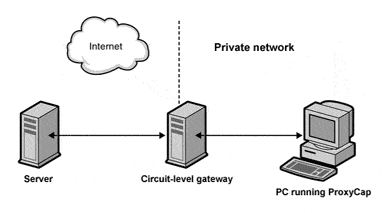Circuit-Level Gateways are specialized firewalls that operate at the session layer, offering a unique approach to managing and securing network traffic. Unlike traditional packet-filtering methods, Circuit-Level Gateways scrutinize and relay IP packets based on their session data, making them an integral component in a multi-layered security strategy.
This article will unfold the layers of Circuit-Level Gateways, revealing their operation, significance, and how they complement other security measures.
Table of Contents:
- What is a Circuit-Level Gateway?
- Understanding the OSI Model and Circuit-Level Gateways
- How Circuit-Level Gateways Work
- Comparing Circuit-Level Gateways with Other Firewall Types
- Implementation and Configuration
- Circuit-Level Gateways in Modern Network Architectures
- References

1. What is a Circuit-Level Gateway?
A Circuit-Level Gateway is a type of firewall that operates at the session layer of the OSI model. Its primary function is to manage and control the initiation and termination of network sessions, thereby offering a unique form of network security. Unlike packet-filtering routers that inspect individual packets, Circuit-Level Gateways focus on the session data encapsulated within the Transmission Control Protocol (TCP) or User Datagram Protocol (UDP) packets.
These gateways establish a secure connection between the internal network and the external network, typically the Internet. Once a session is established, the Circuit-Level Gateway Firewall effectively masks the details of the internal network from the external world. This is achieved by relaying packets without exposing the internal IP addresses, thereby providing anonymity and added security.
Method of Operation
An essential aspect of Circuit-Level Gateways is their method of operation. They do not inspect the contents of each packet deeply; instead, they validate the legitimacy of the session based on pre-determined rules and criteria. By focusing on the session rather than the individual packets, these gateways offer a balance between security and performance, making them ideal for environments where high throughput and reliable connectivity are essential.

Circuit-Level Gateways are often used in conjunction with other firewall technologies, such as application layer proxies and packet filters, to create a comprehensive and layered security framework. This multi-faceted approach allows for finer control over network traffic, enhancing overall security without significantly impacting network performance.
2. Understanding the OSI Model and Circuit-Level Gateways
Overview of the OSI Model
The Open Systems Interconnection (OSI) model is a conceptual framework used to understand and standardize the functions of a telecommunication or computing system. The OSI model divides these functions into seven distinct layers, each responsible for specific network tasks. From bottom to top, these layers are: Physical, Data Link, Network, Transport, Session, Presentation, and Application.
Each layer serves a unique purpose in the processing and transmission of data. For example, the Physical layer deals with the hardware aspects of data transmission, while the Network layer handles the routing of data across networks. The Transport layer ensures data is transferred reliably and in the correct sequence. This layered approach allows for modularity and standardization in network protocols and communications.
The Role of Circuit-Level Gateways in the OSI Framework
Circuit-Level Gateways operate at the Session layer of the OSI model. This layer is crucial as it establishes, manages, and terminates the connections between two or more communicating hosts. The Session layer’s primary role is to provide a mechanism for opening, maintaining, and closing these connections, ensuring a consistent and reliable communication channel.
Circuit-Level Gateway Firewalls leverage this layer to control the flow of network traffic. They act as a gatekeeper, monitoring session initiation requests and determining whether these requests are legitimate and adhere to the predefined security policies. By functioning at the Session layer, Circuit-Level Gateways can effectively manage and control network connections without delving into the deeper content of the data packets, striking a balance between security and efficiency.
3. How Circuit-Level Gateways Work
Session Initiation Process
The session initiation process is the first step in the operation of a Circuit-Level Gateway. When a request to establish a network session is received, the gateway scrutinizes the request to ensure it complies with the network’s security protocols. This involves checking the source and destination addresses, the protocol being used (TCP or UDP), and other session initiation parameters.
Once the gateway confirms that the session initiation request is valid and safe, it establishes a connection. This connection acts as a relay point between the internal and external networks, allowing data packets to be transferred while maintaining the anonymity and security of the internal network.
Traffic Management and Control
After establishing a session, Circuit-Level Gateways play a critical role in managing and controlling the flow of traffic. They ensure that the data packets transmitted during the session are associated with the approved session, preventing unauthorized data from infiltrating the network.
One of the key functions of these gateways in traffic management is the ability to close sessions that are idle or deemed unsafe. This proactive approach to session management enhances the network’s security by reducing the risk of unauthorized access or data leakage.
Circuit-level gateways manage traffic without inspecting the contents of each packet, instead focusing on session-level attributes. This method is efficient and less resource-intensive, allowing for faster data transmission and reduced processing load on the network infrastructure.
4. Comparing Circuit-Level Gateways with Other Firewall Types
Differences from Packet-Filtering and Stateful Firewalls
Circuit-Level Gateways, Packet-Filtering, and Stateful Firewalls each offer distinct approaches to network security.
Packet-Filtering Firewalls operate at the Network layer of the OSI model. They analyze incoming and outgoing packets, making decisions based on source and destination IP addresses, ports, and protocols. These firewalls do not maintain a state and evaluate each packet in isolation, which can be less resource-intensive but potentially less secure.
Stateful Firewalls, on the other hand, are more advanced. Operating at the Network and Transport layers, they inspect packet data but also keep track of the state of active connections (session information). This allows them to understand the context of network traffic, offering greater security but at the cost of higher complexity and resource usage.
Circuit-Level Gateway Firewalls differ from these as they operate at the Session layer. Their focus is on the establishment and maintenance of secure connections rather than inspecting individual packets or their content. This approach provides efficiency in handling data flow but might miss more granular threats that a packet or stateful firewall could catch.
Advantages and Limitations
The primary advantage of Circuit-Level Gateways is their efficiency in managing sessions without the overhead of deep packet inspection. This makes them suitable for environments where speed and resource management are critical.
However, their limitations lie in their lack of deep packet inspection. Unlike stateful or packet-filtering firewalls, Circuit-Level Gateways might not detect certain types of threats that are hidden within the data payload of a packet.
5. Implementation and Configuration
Best Practices for Deployment
- Strategic Placement: Position the Circuit-Level Gateways strategically within your network architecture to effectively manage sessions between trusted and untrusted networks.
- Robust Security Policies: Develop comprehensive security policies for session initiation and management. This includes defining allowed protocols, IP addresses, and ports.
- Regular Updates and Maintenance: Keep the gateway software updated to ensure security against emerging threats.
Configuration Examples
- Session Timeout Settings: Configure session timeout intervals to close inactive connections, reducing vulnerability to unauthorized access.
- Allowed Protocols: Define which protocols (TCP/UDP) are permitted and under what circumstances, aligning with the organization’s network usage patterns.
6. Circuit-Level Gateways in Modern Network Architectures
Integration with Other Security Measures
Circuit-Level Gateways are often part of a layered security approach, complementing other security measures like Intrusion Detection Systems (IDS), anti-virus solutions, and more comprehensive firewall solutions. This integration is crucial for creating a robust defense-in-depth strategy.
Case Studies and Real-World Applications
- Enterprise Networks: In corporate environments, Circuit-Level Gateway Firewalls are integrated with other security systems to provide fast and secure network access control, especially for remote access scenarios.
- E-commerce Platforms: They are used to manage secure sessions for transactions, balancing the need for security and efficient data flow.
7. References
- Books:
- “Network Security Essentials” by William Stallings
- “Firewalls and Internet Security: Repelling the Wily Hacker” by William R. Cheswick, Steven M. Bellovin, and Aviel D. Rubin
- RFCs:
- Academic Papers:
- “A Comparative Study of Different Firewall Technologies” – International Journal of Computer Network and Information Security
- “Design and Implementation of a Session Layer Firewall” – IEEE Xplore
- “Emerging Threats in Cybersecurity: A Comprehensive Review” published in the Journal of Computer Networks and Communications – An insightful paper on the evolving threat landscape.
- Network Encyclopedia
- “Security Devices in Computer Networks Unveiled“, by Mike VP, Sep 5, 2023
- “Firewall“, by Editorial Team, Jan 1, 2023
- YouTube: Circuit-Level Gateway – a higher-level firewall.